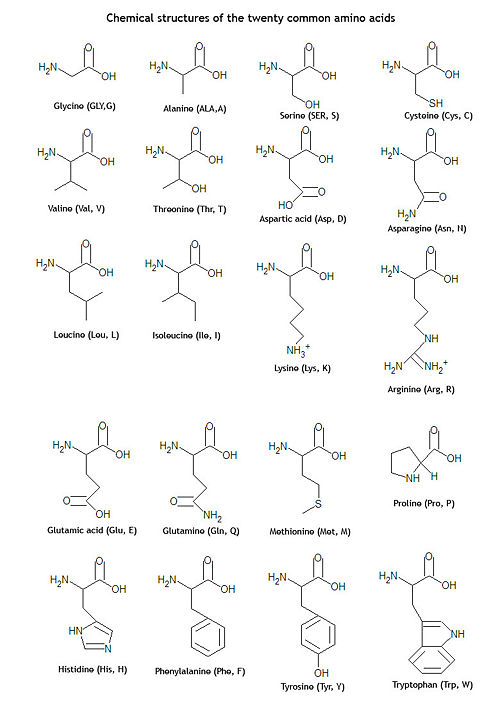Amino acid: Difference between revisions
imported>David E. Volk m (swap aspartic acid/aspartate & glutamic acid/glutamate) |
imported>Anthony.Sebastian (language development) |
||
| (4 intermediate revisions by 2 users not shown) | |||
| Line 1: | Line 1: | ||
{{subpages}} | {{subpages}} | ||
[[Image:Twenty amino acid | [[Image:Twenty amino acid structures3.jpg|right|thumb|500px|{{#ifexist:Template:Twenty amino acid structures2.jpg/credit|{{Twenty amino acid structures2.jpg/credit}}<br/>|}}Amino acid structures.]] | ||
In [[biochemistry]], an <math>\alpha</math>-'''amino acid''' is an [[organic chemistry|organic]] [[monomer]] consisting of an [[amino group]], a [[carboxyl group]], a [[hydrogen]] atom, and a residual group (commonly denoted as simply "R") [[covalent bond|covalently]] bonded to a central (alpha) carbon (C<sub><math>\alpha</math></sub>). Amino acids | In [[biochemistry]], an <math>\alpha</math>-'''amino acid''' is an [[organic chemistry|organic]] [[monomer]] consisting of an [[amino group]], a [[carboxyl group]], a [[hydrogen]] atom, and a residual group (commonly denoted as simply "R") [[covalent bond|covalently]] bonded to a central (alpha) carbon (C<sub><math>\alpha</math></sub>). Amino acids can link via [[peptide bond|peptide bonds]] to create short chains (polymers) called [[polypeptide|polypeptides]], often referred to simply as peptides. Longer, more complex chains (or combinations of multiple chains) are called [[protein|proteins]], which have a vast array of biological functions. In peptides and proteins, the R-groups are often called "side chains", because they are not involved in the polymer backbone. | ||
Amino acids have two stereo isomers (mirror images of each other), and only the L-isomer is used in protein synthesis. | Amino acids have two stereo isomers (mirror images of each other), and only the L-isomer is used in protein synthesis. | ||
| Line 15: | Line 15: | ||
:*[[Leucine]] (Leu, L) | :*[[Leucine]] (Leu, L) | ||
:*[[Isoleucine]] (Ile, I) | :*[[Isoleucine]] (Ile, I) | ||
:*[[Methionine]] (Met, M) | :*[[Methionine]] (Met, M), which may be demethylated to [[homocysteine]]. | ||
====Amino Acids with [[Aromatic]] R-Groups==== | ====Amino Acids with [[Aromatic]] R-Groups==== | ||
| Line 37: | Line 37: | ||
====Amino Acids with [[Electric charge|Negatively Charged]] R-Groups==== | ====Amino Acids with [[Electric charge|Negatively Charged]] R-Groups==== | ||
:*[[Aspartic acid]], or aspartate (Asp, D) | :*[[Aspartic acid]], or aspartate (Asp, D) | ||
:*[[ | :*[[Glutamic acid]] or glutamate (Glu, E) | ||
==Synthesis== | ==Synthesis== | ||
Most organisms are unable to [[synthesis|synthesize]] all twenty amino acids. ''Essential'' amino acids must be taken in from the environment, whereas ''nonessential'' amino acids can be produced by the organism. For humans, there are seven essential amino acids that must be obtained in the [[diet]] in order to survive; there are therefore thirteen non-essential amino acids for humans. The number of and the identity of the essential amino acids varies among [[species]]. | Most organisms are unable to [[synthesis|synthesize]] all twenty amino acids. ''Essential'' amino acids must be taken in from the environment, whereas ''nonessential'' amino acids can be produced by the organism. For humans, there are seven essential amino acids that must be obtained in the [[diet]] in order to survive; there are therefore thirteen non-essential amino acids for humans. The number of and the identity of the essential amino acids varies among [[species]]. | ||
For humans, the nonessential amino acids can be synthesized in [[cell (biology)|cells]] through a variety of pathways. | For humans, the nonessential amino acids can be synthesized in [[cell (biology)|cells]] through a variety of pathways. For some animals, the amino acid [[carnitine]] is essential, but most animals can produce it from lysine. | ||
==See Also== | ==See Also== | ||
Latest revision as of 21:24, 16 February 2010
In biochemistry, an -amino acid is an organic monomer consisting of an amino group, a carboxyl group, a hydrogen atom, and a residual group (commonly denoted as simply "R") covalently bonded to a central (alpha) carbon (C). Amino acids can link via peptide bonds to create short chains (polymers) called polypeptides, often referred to simply as peptides. Longer, more complex chains (or combinations of multiple chains) are called proteins, which have a vast array of biological functions. In peptides and proteins, the R-groups are often called "side chains", because they are not involved in the polymer backbone. Amino acids have two stereo isomers (mirror images of each other), and only the L-isomer is used in protein synthesis.
The Amino Acids
There are twenty common amino acids used by nearly all living organisms as well as several rarer ones. The difference between any two amino acids is the residual (R) group, and they can be categorized based on the chemical properties of the R-groups. Each amino acid has a three-letter abbreviation and a one-letter symbol.
Amino Acids with Non-Polar R-Groups
- Glycine (Gly, G)
- Alanine (Ala, A)
- Valine (Val, V)
- Leucine (Leu, L)
- Isoleucine (Ile, I)
- Methionine (Met, M), which may be demethylated to homocysteine.
Amino Acids with Aromatic R-Groups
- Phenylalanine (Phe, F)
- Tyrosine (Tyr, Y)
- Tryptophan (Trp, W)
Amino Acids with Polar, Uncharged R-Groups
Amino Acids with Positively Charged R-Groups
Amino Acids with Negatively Charged R-Groups
- Aspartic acid, or aspartate (Asp, D)
- Glutamic acid or glutamate (Glu, E)
Synthesis
Most organisms are unable to synthesize all twenty amino acids. Essential amino acids must be taken in from the environment, whereas nonessential amino acids can be produced by the organism. For humans, there are seven essential amino acids that must be obtained in the diet in order to survive; there are therefore thirteen non-essential amino acids for humans. The number of and the identity of the essential amino acids varies among species.
For humans, the nonessential amino acids can be synthesized in cells through a variety of pathways. For some animals, the amino acid carnitine is essential, but most animals can produce it from lysine.

